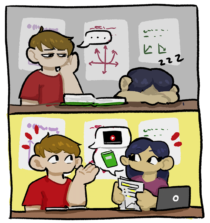

Ancient textbooks are falling apart at the seams, with jokes scribbled in the margins and publication dates from before teachers were born: suggestions for an updated curriculum often entail tossing them out. However, finding alternative materials that adhere to state guidelines would prove costly for the school district.
Instead, the district should take a more holistic approach to learning. In 1992, Neil D. Fleming and Coleen E. Mills identified four different learning styles — visual, auditory, reading or writing and kinesthetic — known collectively as the VARK learning styles. Following this model, districts have a responsibility and must cater to students who fall across this spectrum.
Even if we update textbooks, they will wear down and lose accuracy and relevance in a few years. Instead, schools should implement learning strategies that involve all the VARK modalities. Fortunately, the switch to distance learning inadvertently forced teachers to make progress into multimodal learning. Due to an abundance of information on the internet, textbooks became less prominent while articles and videos became more frequently used tools. In biology, videos conceptualize textbook readings; in modern world history, documentaries emphasize the significance of historical events; in language classes, matching activities on Google Slides are a fun way to learn vocabulary in new languages.
“There needs to be enhanced relevance in our … curriculum.”
The transition to in-person learning is a perfect opportunity to make much-needed curriculum changes. Such changes would grant students who don’t grasp traditional reading and writing methods a fair chance to understand the material. A friend of mine at a local private school struggled to comprehend the different aspects of a civilization, but a project involving a model civilization prompted her understanding. Innovative curriculum assists students in engaging with concepts in a logical way.
Much of the curriculum is rooted in outdated biases, such as Eurocentric views on history or primarily Caucasian authors in English. Schools must provide students with more diverse perspectives that will broaden their global view.
In fall of 2020, the San Mateo County grand jury released “Hate@Schools — Opportunities Lost,” a report detailing the district’s current methods of tackling hate crimes and recommendations to improve based on their findings. In both the report and the district’s response, the solutions revolve around training staff to handle specific incidents and clarifying written policies. An inclusive curriculum, which addresses hate issues from multiple perspectives, would also be instrumental in combating the issues described in the grand jury report. The response would demonstrate how the values being enforced apply to both academic and interpersonal aspects of school.
In addition to reading classics like “Romeo and Juliet” in English class, my friend living in Georgia was required to read South African comedian Trevor Noah’s autobiography “Born a Crime,” which details his experience growing up mixed-race in the Apartheid, which was a system of segregationist legislation against non-whites in South Africa. Incorporating a novel by a well-known figure into the syllabus gave students a unique understanding of international affairs. By incorporating diverse materials into our district curriculum, students will develop a multidimensional outlook on the world.
Along with new perspectives, there needs to be enhanced relevance in our school curriculum. The topics we cover in school often feel disconnected from reality, discouraging students from engaging in class. Learning about RNA in biology might be boring, but connecting this to the mRNA COVID-19 vaccines would prepare students to apply their knowledge to real-world concepts. Because the pandemic was an issue affecting every student in the class, my friend who studied it in class found deeper value in their assignment.
During the pandemic, I examined our curriculum under a new lens, highlighting flaws that previously went unnoticed. Without innovating our learning practices, our classrooms will be permanently stuck in the past, remaining out of touch with the evolving world.





